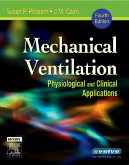|
|
|
| |
 |
|
|

|
 推薦指數:
推薦指數:





|
|
- 內容介紹
|
Mechanical Ventilation, 4th Edition - Physiological and Clinical Applications
By Susan P. Pilbeam, MS, RRT, FAARC and J. M. Cairo, PhD, RRT, FAARC
672 pages 395 ills
Trim size 8 1/2 X 10 7/8 in
Copyright 2006
團體訂購另有折扣
現貨供應
Description
Reorganized to better reflect the order in which mechanical ventilation is typically taught, this text focuses on the management of patients who are receiving mechanical ventilatory support and provides clear discussion of mechanical ventilation and its application. The 4th edition features two-color illustrations, an increased focus on critical thinking, a continued emphasis on ventilator graphics, and several new chapters including non-invasive positive pressure ventilation and long-term ventilation.
Key Features
Excerpts of the most recent CPGs are included to give students important information regarding indications/contraindications, hazards and complications, assessment of need, assessment of outcome, and monitoring.
Clinical Rounds boxes contain problems that may be encountered during actual use of equipment and raise questions for the student to answer.
Case studies are included as boxes throughout the chapters within boxes and Clinical Rounds.
Historical Notes provide educationally or clinically relevant information.
New to this Edition
Chapters featuring topics such as methods to improve ventilation, frequently used pharmacologic agents in ventilated patients, cardiovascular complications, pulmonary complications, noninvasive positive pressure ventilation, and long-term ventilation have been added.
Key Point boxes have been placed sporadically throughout the chapters and highlight key information for the reader.
Increased number of NBRC-type questions reflecting the types of questions and amount of coverage on the board exams.
Respected educator J.M. Cairo has been added as co-author, bringing in a fresh voice and a wide breadth of experience.
A reorganization of chapters creates a text that is more in line with the way the course is typically taught.
lAll chapters have been heavily revised and updated, particularly the chapters on ventilator graphics, methods to improve oxygenation, and neonatal and pediatric ventilation.
A second color has been added to enhance the overall design and line drawings.
Key terms are listed at the beginning of each chapter and highlighted at first mention.
Table of Contents
Part I: Basic Concepts and Core Knowledge in Mechanical Ventilation
1. Oxygenation and Acid-Base Evaluation
2. Basic Terms and Concepts of Mechanical Ventilation
3. How Ventilators Work
4. How a Breath Is Delivered
Part II: Initiating Ventilation
5. Establishing the Need for Mechanical Ventilation
6. Selecting the Ventilator and the Mode
7. Initial Ventilator Settings
8. Final Considerations in Ventilator Setup
Part III: Monitoring in Mechanical Ventilation
9. Initial Patient Assessment with Mechanical
10. Ventilator Graphics
11. Noninvasive Monitoring of Mechanically-Ventilated Patients
12. Hemodynamic Monitoring
Part IV: Therapeutic Interventions – Making Appropriate Changes
13. Methods to Improve Ventilation and Other Techniques in Patient-Ventilator Management
14. Improving Oxygenation, Review of ARDS and Lung Recruitment Maneuvers
15. Frequently Used Pharmacologic Agents in Ventilated Patients: Sedatives, Analgesics and Paralytics
Part V: Effects and Complications of Mechanical Ventilation
16. Cardiovascular and Organ System Effects and Complications of Mechanical Ventilation
17. Effects of Positive Pressure Ventilation on the Pulmonary System
18. Problem-Solving and Troubleshooting
Part VI: Noninvasive Positive Pressure Ventilation
19. Basic Concepts of Noninvasive Positive Pressure Ventilation
Part VII: Discontinuation from Ventilation and Long-Term Ventilation
20. Weaning and Discontinuation
21. Long-Term Ventilation
Part VIII: Special Applications of Mechanical Ventilation
22. Neonatal and Pediatric Ventilation
23. Special Techniques in Ventilatory Support
Appendices
|
|
|

